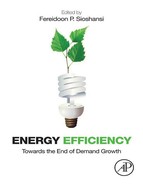Is Zero Energy Growth in Our Future?
In the year 2010, 50 energy experts were polled about the likely impact of energy efficiency on future electricity use in the year 2020.1 They said that it would lower energy consumption by 5 to 15 percent and that peak demand would be lowered by 7.5 to 15 percent.2
So what do the results portend? If these reductions are applied to the 1 percent annual growth rate in energy consumption and peak demand that seems to be the consensus projection these days, the result is zero growth.
Some of us recall the book, The Limits to Growth, which was published in 1972 by the Club of Rome. Partly for its messianic tone and partly for its Malthusian conclusions, the book was immediately panned by academics.With some critics, the “systems dynamics” model at the heart of Limits did not cut the mustard. William Nordhaus’ entitled his critique in The Economic Journal “Measurement without data” (http://nordhaus.econ.yale.edu/worlddynamics.pdf).
Acceptance of the book’s policy conclusions was slow. In 1976, Amory Lovins lamented that no one was taking the so-called “soft path” to solving the world’s constrained resource problems.3 Concurrently, at the California Energy Commission, a band of graduate students from UC Davis were assembling the first genre of econometrically structured end-use models under the tutelage of professors Leon Wegge and Dan McFadden. Using these models, they prognosticated the end of the Seven Percent Growth Era. The “culprits” would be many and would include price elasticity (which some insisted back then was zero since electricity was a necessity), appliance codes, and building standards (which some insisted equated to a form of communism that Lenin would have cherished).
Nobody believed us then. We were called neo-Malthusians by at least one academic (who would became famous for propounding the Rebound Effect Theory, which averred that energy efficiency programs would actually cause consumption to bounce back to prior levels).
However, four decades on, the Limits to Growth book has proved prescient. In 2008 Graham Turner examined the past thirty years of data with the forecasts made by the Limits and found that changes in industrial production, food production, and pollution were all in line with the book’s predictions. That is remarkable given that Limits was written when green was just a color and not the name of a movement and when climate change was not a household word, let alone the focus of a film.
The future remains impossible to predict. Some continue to believe that new end-uses, not yet invented in Silicon Valley, will overwhelm improvements in energy efficiency brought on by smarter appliances and fuel another boom in electricity growth. But more and more analysts are anticipating a slow-down in growth, maybe even a crawl to zero growth.
The debate about zero growth will linger. Participants on both sides of the debate, passionate in their pursuit of the truth, would do well to heed the wisdom of management guru Peter Drucker, “The best way to predict the future is to create it.” Energy efficiency and demand response provide arguably the best way of creating it. Even with the likelihood of a zero growth world, concerns about the limitations of our natural resources will always necessitate having energy efficiency and demand response policies and programs in place. Furthermore, there is a mountain of evidence indicating that these policies and programs are effective, economically attractive, and appealing to customers.
Ahmad Faruqui
The Brattle Group
1Chapter 1 includes further details of this survey.
2http://papers.ssrn.com/sol3/papers.cfm?abstract_id=2029150
3“Energy Strategy: The Road Not Taken,” Foreign Affairs, 1976; http://www.foreignaffairs.com/articles/26604/amory-b-lovins/energy-strategy-the-road-not-taken.
